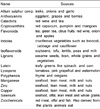Abstract
Nutrition is essential for our health. Various foods we take everyday are essential to live. Nutrients interact within and between all relevant biological, social and environmental systems. Because of the lack of evidence we don't realize that nutritional problems are critical. But, nutrition is a very critical for treatment and prevention of diseases. So, there is huge interest in the area of nutrition and health, including nutrigenetics and nutrigenomics. Especially, the importance of micro-nutrients is revealed in many aspects of health, especially in chronic diseases. Diabetes Mellitus is an example. Depletion and unbalanced micro-nutrients can create very severe illnesses, so an integrative approach on nutrition is very important.
References
1. Goldsmith GA. Clinical nutritional problems in the United States. Nutr Rev. 1965. 23:1–3.
3. Lachance PA, Nakat Z, Jeong WS. Antioxidants; An integrative approach. Nutrition. 2001. 17:835–838.

5. Salganik RI. The benefits and hazards of antioxidants; Controlling apoptosis and other protective mechanism in cancer patientsand the human population. J Am Coll Nutr. 2001. 20:5 Suppl. 464S–472S.
6. Suskind DL. Nutritional deficiencies during normal growth. Pediatr Clin North Am. 2009. 56:1035–1053.

7. Ortiz-Andrellucchi A, Henríquez-Sánchez P, Sánchez-Villegas A, Peña-Quintana L, Mendez M, Serra-Majem L. Dietary assessment methods for micronutrient intake in infants, children and adolescents: a systematic review. Br J Nutr. 2009. 102:Suppl 1. S87–S117.

8. Benzie I, Wachtel-Galor S. Vegetarian Diets and Public Health: Biomarker and Redox Connections. Antioxid Redox Signal. 2010. 13:1575–1591.

9. Brown LA, Riby LM, Reay JL. Supplementing cognitive aging: a selective review of the effects of ginkgo biloba and a number of everyday nutritional substances. Exp Aging Res. 2010. 36:105–122.

10. Goralczyk R. Beta-carotene and lung cancer in smokers: review of hypotheses and status of research. Nutr Cancer. 2009. 61:767–774.

12. Silver HJ. Oral strategies to supplement older adults' dietary intakes: comparing the evidence. Nutr Rev. 2009. 67:21–31.

13. Park S, Johnson M, Fischer JG. Vitamin and mineral supplements: barriers and challenges for older adults. J Nutr Elder. 2008. 27:297–317.

14. Resnick LM. Ionic basis of hypertension, insulin resistance, vascular disease, and related disorders. The mechanism of "syndrome X". Am J Hypertens. 1993. 6:123S–134S.

15. Tosiello L. Hypomagnesemia and diabetes mellitus. A review of clinical implications. Arch Intern Med. 1996. 156:1143–1148.

16. Barbagallo M, Gupta RK, Bardicef O, Bardicef M, Resnick LM. Altered ionic effects of insulin in hypertension: role of basal ion levels in determining cellular responsiveness. J Clin Endocrinol Metab. 1997. 82:1761–1765.

17. Barbagallo M, Dominguez LJ, Galioto A, Ferlisi A, Cani C, Malfa L, Pineo A, Busardo' A, Paolisso G. Role of magnesium in insulin action, diabetes and cardiometabolic syndrome X. Mol Aspects Med. 2003. 24:39–52.

18. Paolisso G, Barbagallo M. Hypertension, diabetes mellitus, and insulin resistance: the role of intracellular magnesium. Am J Hypertens. 1997. 10:346–355.

19. Grimaldi BL. The central role of magnesium deficiency in Tourette's syndrome: causal relationships between magnesium deficiency, altered biochemical pathways and symptoms relating to Tourette's syndrome and several reported comorbid conditions. Med Hypotheses. 2002. 58:47–60.

20. Djahanschiri H, Brune H. [Effect of chromium as a trace element on glucose regulation in rats Distribution and retention of various quantities of chrome in the organism]. Z Tierphysiol Tierernahr Futtermittelkd. 1975. 35:40–50.
21. Djordjević PB, Dimitrijević V, Maksimović R, Vrvić M, Vucetić J. Application of organic bound chrome in disturbed glycoregulation therapy. Transplant Proc. 1995. 27:3333–3334.
22. Wegener WS, Romano AH. Zinc stimulation of RNA and protein synthesis in Rhizopus Nigricans. Science. 1963. 142:1669–1670.

23. Millar MJ, Elcoate PV, Mawson CA. Sex hormone control of the zinc content of the prostate. Can J Biochem Physiol. 1957. 35:865–868.

24. Emanuel MB, Oakey RE. Effect of Zn++ on the binding of oestradiol-17 beta to a uterine protein. Nature. 1969. 223:66–67.

25. Cherian MG. Studies on the synthesis and metabolism of zinc-thionein in rats. J Nutr. 1977. 107:965–972.

26. Taly AB, Prashanth LK, Sinha S. Wilson's disease: An Indian perspective. Neurol India. 2009. 57:528–540.

27. Doering P, Stoltenberg M, Penkowa M, Rungby J, Larsen A, Danscher G. Chemical blocking of zinc ions in CNS increases neuronal damage following traumatic brain injury (TBI) in mice. PLoS One. 2010. 5:e10131.

28. Frumar AM, Meldrum DR, Geola F, Shamonki IM, Tataryn IV, Deftos LJ, Judd HL. Relationship of fasting urinary calcium to circulating estrogen and body weight in postmenopausal women. J Clin Endocrinol Metab. 1980. 50:70–75.

29. Green J, Diplock AT, Bunyan J, Muthy IR, McHale D. Vitamin E and stress. 4. The metabolism of D-alphatocopherol during nutritional hepatic necrosis in the rat and the effects of selenium, methionine and unsaturated fatty acids. Br J Nutr. 1967. 21:497–506.
30. Desai ID. Beneficial and ineffective levels of selenium for growth and muscular dystrophy. Br J Nutr. 1968. 22:645–650.

31. Myklebust M. The healing foods pyramid: an integrative nutrition tool. Explore (NY). 2006. 2:352–356.





 PDF
PDF ePub
ePub Citation
Citation Print
Print






 XML Download
XML Download